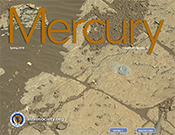Spring 2018 - Volume 47, Number 2

Table of Contents
[24] Above It All, Steve Murray
High-altitude balloons are a cheaper alternative to launching instruments into space, but they have their challenges.
[31] Digging Deep, Tracy Staedter
The Martian interior is an enigma; NASA’s InSight lander will change that.
[36] 20,000 Alien Worlds Await, Matthew R. Francis
NASA’s Transiting Exoplanet Survey Satellite will search most of the sky in its hunt for planets and other astronomical phenomena.
[22] Cosmic Views: Jupiter's Cyclone Carousel, Jason Major
[47] Astronomy in the News Ian O'Neill
Departments
[3] Perspectives, Ian O'Neill
How Much Is Too Much?
[4] First Word, Linda Shore
Farewell, Stephen
[6] Annals of Astronomy, Clifford Cunningham
Finding Syzygy in the 14th Century
[8] Research Focus, M. Katy Rodriguez Wimberly
The Curious Case of Empty Dark Matter Halos
[10] Research Focus, Adrianna Brown
Black Holes and Galaxies: A Gravitational Love Story
[13] Astronomer’s Notebook, Jennifer Birriel
Dark Matter... Or Something Else?
[15] Armchair Astrophysics, Christopher Wanjek
Black Holes Grow Faster (And Slower) Than Assumed
[17] Education Matters, Brian Kruse
A Tenth of a Pixel
[19] A Little Learning, C. Renee James
Who Knew?
[44] Reflections, Ian O'Neill
Above It All
By Steve Murray
Earth’s atmosphere is rarely a friend to astronomers. While many scientists rely on rocket-launched space probes to solve this problem, researchers are choosing high-performance balloons as a less expensive, less complex, and more expeditious route to the edge of space. Scientific balloons fill an important niche between ground-based observatories and full-on space missions and, as their capabilities improve, other science communities are beginning to pay attention.
Digging Deep
By Tracy Staedter
Scientists have only scratched the surface of Mars. Since NASA’s Mariner 4 flew by the Red Planet in 1965, another two-dozen spacecraft have gathered information about the planet’s atmosphere, topography, ground-level rocks and minerals, and general details about its size and density using external observations. Now a new mission called InSight is going deep.
20,000 Alien Worlds Await
By Matthew R. Francis
NASA’s Kepler space telescope and its follow-up K2 mission have been an overwhelming success, discovering eight thousand possible worlds orbiting other stars. After more than nine years of operation, the exoplanet observatory is finally reaching its end as it runs out of fuel. But researchers are already looking forward to the next big mission: the Transiting Exoplanet Survey
Satellite (TESS).
Jupiter’s Cyclone Carousel
By Jason Major
NASA’s Juno mission has revealed that Jupiter’s poles feature rings of gigantic cyclones spinning in formation. Each of these cyclones is enormous in its own right – easily big enough to span the Atlantic Ocean — and somehow they all manage to avoid merging with their respective neighbors via some as yet unknown process.
A Fingerprint of the Earliest Stars
By Ian O’Neill
Our Universe reverberates with the ancient afterglow of the Big Bang. Studying the characteristics of this faint glow — called the Cosmic Microwave Background (CMB) — can reveal the structure of the Universe’s first moments. But, as revealed in new research published across four Nature studies in February, the CMB’s photons can also be used to reveal the sparkle of “cosmic dawn”—the moment the first population of stars were born.
